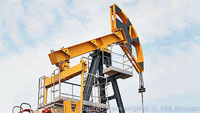NEWSLINK: Russian Oil Industry at a Crossroads as Infrastructure Ages

[Russian Oil Industry at a Crossroads as Infrastructure Ages – International Herald Tribune – Thane Gustafson – Dec. 5, 2012 – Thane Gustafson is a professor of government at Georgetown University and a senior director at IHS Cambridge Energy Research Associates. His latest book is “Wheel of Fortune: The Battle for Oil and Power in Russia.” – Click here for full article]
Thane Gustafson writes on the Russian oil industry and its infrastructure in the International Herald Tribune.
Russian oil production has returned almost to Soviet levels:
The Russian oil industry is at a crossroads. In the aftermath of the collapse of the Soviet Union, Russian oil output plummeted from an all-time high of 11.4 million barrels a day in 1987 to a low of 6 million barrels a day in 1996. But with the start of the new century, a stunning rebound began. And in the past few years, output has returned to a level close to its Soviet-era peak.
But Russian oil production is encountering limits and could decline:
… there are signs of trouble. The industry’s traditional core, the giant West Siberian fields inherited from the Soviet Union, has been in decline since 2007. And while overall Russian production continues to inch upward (about 1.6 percent so far this year), that is thanks only to a strong burst of drilling in the older fields, plus the development of a handful of new fields at the periphery of the country.
Russia vies with Saudi Arabia as the world’s largest oil producer. But there is one crucial difference: Saudi Arabia has spare capacity and could increase output substantially. Russia, in contrast, is producing flat-out, close to the limit of its current capacity. Indeed, Russian oil production could well slip in the next few years.
This would be yet a new phase in the tumultuous history of Russian oil. The Russian government’s own experts have warned President Vladimir V. Putin that unless urgent measures are taken soon, production could sink as low as eight million barrels a day by 2020.
Russia is one of the world’s top-two oil producers, representing 12 per cent of world output. And Russia is a top oil exporter, nearly 5 million barrels per day.
For Russia itself, more than 50 per cent of Russian export income is from oil, and 40 per cent of the government’s budget revenue.
Yet Russia has been relying on older oil fields:
… behind these numbers lies an inexorable fact: For the past twenty years Russia has largely been coasting on the oil fields inherited from the Soviet Union. Now the Soviet-era legacy is running down. …
While Russia has oil available in difficult environments, technology has advanced to obtain oil from diverse and challenging environments. But Russia has only started heading down that path, now seeking to do so further by entering large deals with outsiders:
… the Russian oil industry works in some of the toughest environments on earth. But in the past thirty years the global oil industry has experienced a revolution in technology that has enabled it to find and produce oil in previously unreachable places.
The Russian oil industry, though it … has modernized extensively … has participated only up to a point. In particular, it has not yet ventured into offshore Arctic fields or into unconventional sources like oil sands or shale.
The reason is straightforward: It has not needed to. But the next generation of Russian oil will have to come from places that are colder, deeper, more remote, geologically more complex and technologically far more demanding than anything Russian companies have tackled to date.
If it is to avert a decline, the country must follow the same path as the rest of the global industry. A series of major deals indicates that this is the direction Russia is beginning to go, but the turn has just begun.
